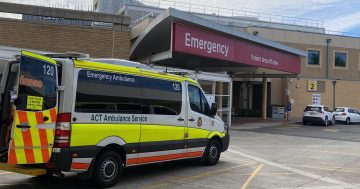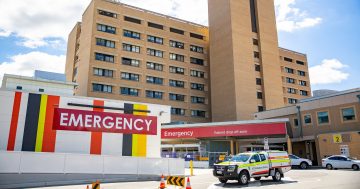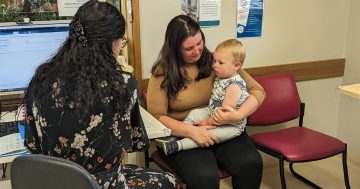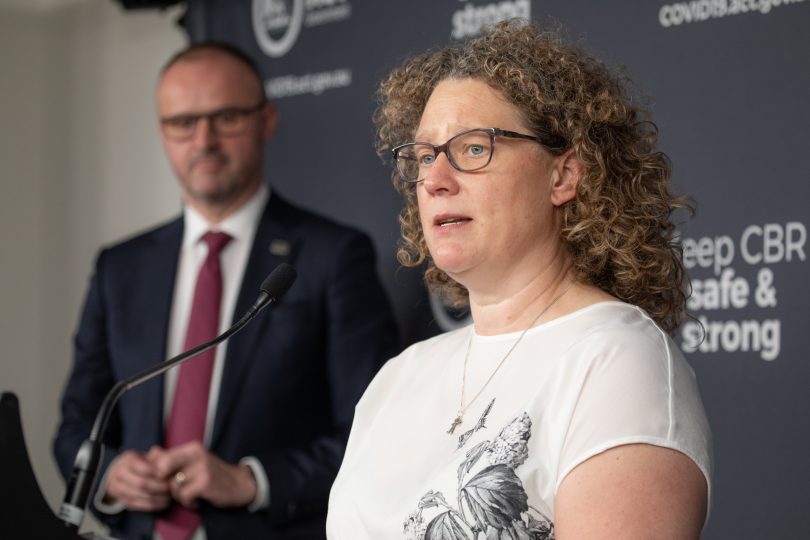
Dr Kerryn Coleman expressed confidence in the ACT’s exemption system and border processes. Photo: Michelle Kroll.
UPDATED 2:25 pm: Chief Minister Andrew Barr said the current public health measures would need to remain in place until vaccination rates increased, ruling out any changes to the current orders in the short term.
“As we get closer to the very high level of vaccination the ACT will achieve … it means that [we can rely less on] the other two measures we use to keep cases as low as possible – test, trace, isolate and quarantine (TTIQ) and public health measures,” he said.
“TTIQ is not perfect. There will always be cases where you do not get the test in time, that do not isolate in time, [and] that is why you still need the public health measures as well.
“As the vaccination rate increases, your system and public health response will rely a bit less on TTIQ and public health measures, but we are still some way away from that because our vaccination rates are not yet high enough.”
Over 70 per cent of the ACT’s population aged 16 and older have received at least one dose, and half of the Territory is expected to be fully vaccinated in about a week.
But despite Australia’s one-page national plan citing only highly targeted lockdowns once the 80 per cent fully vaccinated threshold is reached, Mr Barr said the ACT may be too small for localised restrictions.
The comments were made after NSW Premier Gladys Berejiklian said the current statewide lockdown would be the state’s last.
Mr Barr said that while the comments made sense for a bigger jurisdiction like NSW, “it probably would not make sense to have a small pocket of Canberra locked down”.
“At times in our city, there can be a north of the lake, south of the lake distinction, [but] there is quite a bit of movement across the lake, so I think our jurisdiction is too small,” he said.
“But of course, these things are subject to the nature of any particular outbreak and the advice from the Chief Health Officer at the time.”
At today’s COVID briefing, Chief Health Officer Dr Kerryn Coleman said 5 per cent of the ACT’s current outbreak cannot be genomically linked to the outbreak, meaning a small number of cases continue to come in from NSW.
Around four or five cases from the total outbreak, which grew to 374 today (5 September), did not have the same genomic pattern as the rest of the ACT’s cases.
“There is a suggestion that there is a small number of cases continuing to come into the ACT from NSW that are not part of our current cluster,” she said.
Forty-seven cases from the current outbreak remain unlinked.
Twenty of these cases were recorded in the last two to three days, and investigations are continuing, and two are in the ‘extremely early’ stage of investigation after being recorded last night.
These more recent cases have the highest chances of being linked, Dr Colemain said, explaining that more unlinked cases and sources of transmission are expected moving forward due to the nature of the delta outbreak.
“We know there is still essential travel required; we know that to live our lives and to have essential services, there needs to be movement in and out [of the ACT],” she said.
Dr Coleman expressed confidence in the ACT’s exemption system and border processes despite the unlinked cases.
“Some of these cases are being identified through our exemption and testing process, so that is our system at work,” she said.
“Given that 95 per cent of cases are linked to the initial cluster, it is working reasonably well. We have identified the cases through our process [but] nothing can ever be 100 per cent perfect.
“We have one of the strongest exemption and testing processes around Australia because we are able to provide individual service to people [coming in with an exemption].”
Health authorities have admitted that not every case will have an identified link during the delta outbreak and that the focus remains on minimising the period of time infectious people spend in the community and reducing the risk of transmission.
“We will not catch everything that comes in,” Dr Coleman said. “[But] we do constantly adjust our risk and the management of people coming in.
“We have a two-pronged process – one is working with individuals around their exemptions and what they need to do when they come in, and the second is this desperate plea to everybody to monitor their symptoms and get tested.”
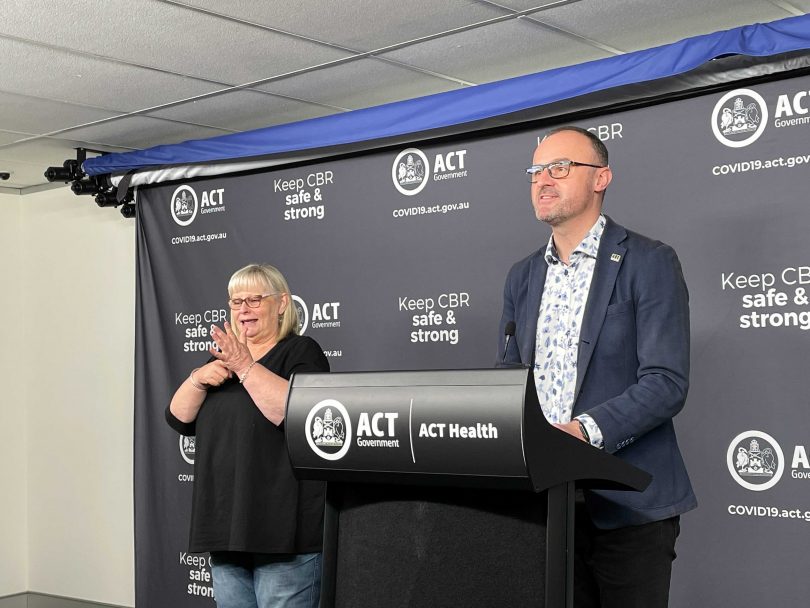
Chief Minister Andrew Barr at this morning’s COVID-19 briefing. Photo: Dominic Giannini.
12.30 pm: There are 15 new cases of COVID-19 in the ACT, less than half of yesterday’s record number.
But health authorities are warning that one in three people who are infectious have waited at least two days after the onset of their symptoms to get tested.
“We are seeing some people, one in three of our cases, who have waited for two days before getting tested after symptoms appear”, Chief Health Officer Dr Kerryn Coleman said at today’s press briefing.
“It is so important to get tested immediately, as soon as you have any symptoms at all.”
The most common symptoms of COVID-19 are fever, cough, sore throat, shortness of breath, loss of smell or taste, runny or blocked nose; the less common symptoms are muscle and joint pain, diarrhoea, nausea, headaches, vomiting, loss of appetite and fatigue.
“Each person may experience a different set of symptoms to the person you are living with in your family,” Dr Coleman said. Some positive cases have no symptoms, making it critical to get tested if you are at an exposure site.
She said many people who were infectious in the community were unaware they had COVID-19, but others have disregarded quarantine rules.
Thirteen of the new cases are linked to current cases or sites and 11 are household contacts, still the majority of new cases. Six were in quarantine during their entire infectious period, but seven spent part of that time in the community and two are under early investigation.
Of the total 374 cases, 237 remain active. Nine people are hospitalised and one is in intensive care on ventilation. Seven of those nine are unvaccinated and two have had their first dose of vaccine.
There are 330 active exposure locations and 16 public transmission sites. These now include the Busy Bees childcare centre at Brindabella and the Priceline pharmacy at Woden. Another case has also been linked to KFC at Dickson.
A total of 325 cases have been linked in some way to known clusters but 47 are still unlinked, although Dr Coleman said that 20 of these were from the last two or three days and tracers are still hopeful of finding a source for them.
Chief Minister Andrew Barr said there is no intention to ease restrictions for the foreseeable short term future, and it was unlikely that there would be differences in restrictions between different areas of Canberra.
Compliance remains strong and Mr Barr said that there had been some improvement in mask wearing at businesses.
The ACT has passed the 70 per cent first dose milestone for the 16-plus population and Canberra is also close to fully vaccinating 50 per cent of the 16-plus population. More than 80 per cent of over 75s are now fully vaccinated.
Year 12s have been allocated priority doses of Pfizer vaccine for a two-week period, starting tomorrow. This will enable them to sit their AST tests in person in October. The Chief Minister urged students to make bookings through their GP or government clinics.
In the ACT, 2508 tests were undertaken yesterday and Mr Barr emphasised the importance of coming forward immediately if you experience any symptoms.
“Every day you wait and see, and hope it might just be a cold, and delay getting tested is a risk to you, your family and your broader community. It’s one reason why people have infectious days in the community. One of the key things driving this is the delay some people have in coming forward to get tested,” he said.
UPDATED 11:55 am: The ACT has recorded 15 new cases of COVID in the 24 hours to 8:00 pm last night.
Yesterday the ACT recorded 32 cases.
Of the 15 new cases, 13 are linked to known exposure sites; six were in quarantine for their entire infectious period; seven spent some of their infectious period in the community; two are under early investigation.
In good news for the ACT, Chief Minister Andrew Barr said there has been a reduction in the number of people requiring urgent medical attention. Nine people are in hospital and one is in intensive care requiring ventilation.
Yesterday 2508 tests were undertaken, but Mr Barr reiterated that if anyone exhibits symptoms – including a sore throat, headache, fever, shortness of breath, muscle aches, cough or runny nose – come forward for testing immediately, and if you have been to identified exposure sites.
“Delay in testing is a risk to you and the community,” he said.
In NSW, Premier Gladys Berejiklian reported 1485 new cases and three deaths. The state also recorded a milestone of 40 per cent of its population now being fully vaccinated.
However, more than 1000 people are in NSW hospitals with COVID-19.
In Victoria, Premier Dan Andrews announced 183 new cases.
There are 89 people in Victorian hospitals with COVID, including 24 in intensive care, of whom 13 are on ventilators.
Only one of those in hospital is fully vaccinated.

Bunnings Warehouse Majura Park. Photo: Michelle Kroll.
9:30 am: Bunnings stores, Cooleman Court, Centrelink in Braddon and Trappers Bakery in Goulburn have all been listed as exposure sites overnight.
People at Bunnings Belconnen on Wednesday (1 September) between 5:00 pm to 6:00 pm or Bunnings Gungahlin on Thursday (2 September) between 12:45 pm and 1:45 pm are being told to monitor for symptoms.
People at Cooleman Court shopping centre between 2:15 pm and 3:00 pm on Thursday (2 September) or between 1:50 pm and 2:40 pm on Monday (30 August) are also being told to monitor for symptoms.
Busy Bees at the Park on 37 Brindabella Circuit has been listed as a close exposure site for most of Monday (30 August), Tuesday, Wednesday and Thursday last week.
Visitors to Coles or ALDI at Chisholm on Wednesday (25 August) between 12:30 pm to 1:45 pm or 11:45 am to 1:15 pm, respectively, are considered casual contacts.
Trappers Bakery in Goulburn has also been listed as an exposure site on Thursday, 26 August, between 8:45 am and 9:30 am. Anyone who was at the bakery during this time must get tested immediately and isolate until they receive a negative result.
Almost 100 new exposure locations across the Territory have been listed.
Several takeaway stores, supermarkets and public transport routes across Belconnen, the Canberra Airport precinct, Canberra city, Chilsom, Dickson, Gungahlin, Hawker, Holt, Phillip, Wanniassa and Weston are listed as exposure sites.
For the full list of exposure locations, visit covid19.act.gov.au.
Chief Minister Andrew Barr, Health Minister Rachel Stephen-Smith and Chief Health Officer Dr Kerryn Coleman will update the ACT’s COVID-19 situation at 11:45 am.
More to come.












